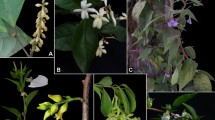Abstract
Chlorpheniramine (CPA) is an antihistaminic that changes the conformation of DNA and inhibits polyamine biosynthesis in mammalian cells. In the present work, we tested the effect of CPA on four genera of fungi species (Altemaria alternata, Botrytis cinerea, Cladosporium cladosporioides and threePenicillium spp.) grownin vitro. Similar growth inhibitions of these genera were produced by 0.5 raM iprodione, CPA and histidinol, but CPA was the most effective. The CPA sensitivities of the twoB. cinerea strains were different. Putrescine did not restore the fungal growth inhibited by CPA.
Similar content being viewed by others
References
Birecka, H., Garraway, M.O., Baumann, R.J. and McCann, P.P. (1986) Inhibition of ornithine decarboxylase and growth of the fungusHelminthosporium maydis.Plant Physiol. 80:798–800.
Brandes, L.J. and LaBella, F.S. (1993) Identification of intracellular histamine receptors. Hic that regulate cell proliferation.in: García-Caballero, M., Brandes, L.J. and Hosoda, S. [Eds.] Advances in the Biosciences. Vol. 89, pp. 31–41. Pergamon Press, Oxford, UK.
Brown, A.M., Walters, D.R. and Robin, D.J. (1990) Effects of three substituted cadaverines on infection of barley with powdery mildew and brown rust.Lett. Appl. Microbiol. 11:130–132.
Cooper, D.G., Young, R.C., Durant, G.J. and Ganellini, C.R. (1990) Histamine receptors.in: Emmett, J.C., Hansch, C., Sammes, P.G. and Taylor, J.B. [Eds.] Comprehensive Medical Chemistry, vol. 3: Membranes and Receptors. pp. 323–421. Pergamon Press, London, UK.
Davis, R.H., Morris, D.R. and Cofino, P. (1992) Sequestered end products and enzyme regulation: The case of ornithine decarboxylase.Microbiol. Rev. 56:280–290.
Havis, N.D., Walters, D.R. and Robins, D.J. (1997) The fungicidal diamine (E)-N,N,N’,N’,-(tetraethyl)-l,4-diaminobutene increases spermine concentration in the late blight fungusPhytophthora infestans.Lett. Appl. Microbiol. 25:229–232.
Matés, J.M., Sánchez-Jiménez, F., López-Herrera, J. and Núñez de Castro, I. (1991) Regulation by 1,4-diamines of the ornithine decarboxylase activity induced by ornithine in perfused tumor cells.Biochem. Pharmacol. 42:1045–1052.
Medina, M.A., García de Veas, R., Morata, P., Lozano, J. and Sánchez-Jiménez, F. (1995) Chlorpheniramine inhibits the synthesis of ornithine decarboxylase and the proliferation of human breast cancer lines.Breast Cancer Res. Treat. 35:187–194.
Medina, M.A., Ramírez, F.J., Ruiz-Chica, J., Chavarría, T., López-Navarrete, J.Y. and Sánchez-Jiménez, F. (1998) DNA-chlorpheniramine interaction studies by spectroscopic techniques.Biochem. Biophys. Acta 1379:129–133.
Medina, M.A., Urdiales, J.L., Núñez de Castro, I. and Sánchez-Jiménez, F. (1991) Diamines interfere with the transport of L-ornithine in Ehrlich-cell plasma-membrane vesicles.Biochem. J. 280:825–827.
Rajam, M.V., Weinstein, L.H. and Galston, A.W. (1985) Prevention of a plant disease by specific inhibition of fungal polyamine bioynthesis.Proc. Natl. Acad. Sci. USA 82:6874–6879.
Robinson, H. and Wang, A.H. (1996) Neomycin, spermine and hexamine cobalt (III) share common structural motifs in converting B to A-DNA.Nucleic Acid Res. 24:676–682.
Sijpesteijn, A.K. (1982) Mechanism of action of fungicides.in: Dekker, J. and Georgopoulos, S.G. [Eds.] Fungicide Resistance in Crops Protection. pp. 32–45. Centre for Agricultural Publishing and Documentation, Wageningen, the Netherlands.
Smith, T.A., Baker, J.H.A. and Jung, M. (1990) Effects of enzyme activated inhibitors on ornithine decarboxylase and growth ofBotrytis cinerea.Phytochemistry 29:1759–1762.
Urdiales, J.L., Matés, J.M., Núñez de Castro, I. and Sánchez-Jiménez, F. (1992) Chlorpheniramine inhibits the ornithine decarboxylase induction of Ehrlich carcinoma growingin vivo.FEBS Lett. 305:260–264.
Viguera, E., Trelles, O., Urdiales, J.L., Matés, J.M. and Sánchez-Jiménez, F. (1994) Mammalian L-amino acid decarboxylases producing 1,4-diamines: analogies among differences.Trends Biochem. Sci. 19:318–319.
Wagner, L.J. and Flores, H.E. (1994) Effect of Taxol and related compounds on growth of plant pathogenic fungi.Phytopathology 84:1173–1178.
Author information
Authors and Affiliations
Corresponding author
Rights and permissions
About this article
Cite this article
Torés, J.A., González, M.D., Pozo, E. et al. The antihistaminic chlorpheniramine inhibitsin vitro growth of several fungi isolated from harvested fruits. Phytoparasitica 27, 207–213 (1999). https://doi.org/10.1007/BF02981460
Received:
Revised:
Issue Date:
DOI: https://doi.org/10.1007/BF02981460




